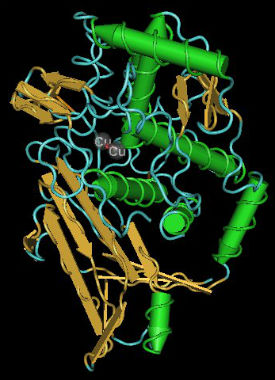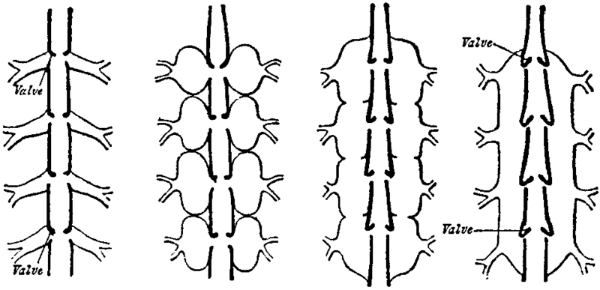Hemolymph
Arthropod blood
Online Biology Dictionary
|
|

|
| Hemocyanin structure |
Hemolymph (Brit. haemolymph) is the fluid in the circulatory system of arthropods (arachnids, crustaceans and insects). Molluscs, too, have a circulatory fluid of this type.
In insects, exchange of oxygen and carbon dioxide occurs in a tracheal system. That is, they respire directly through their body surfaces. So the circulatory system transports nutrients, but relatively little oxygen. However, in both insects and other arthropods, as well as molluscs, hemolymph does contain hemocyanin, a copper-based oxygen transporter molecule.
Because of the presence of hemocyanin, the circulatory fluid of these organisms turns blue-green when oxygenated. When deoxygenated, it is colorless or gray. In contrast, the erythrocytes of vertebrates contain iron-based hemoglobin, which is bright red when oxygenated, dark red (maroon) when not.
Certain insects that live in low-oxygen environments have been found also to have hemoglobin (in addition to hemocyanin), which provides them with a more efficient oxygen transport system. Some molluscs, such as the Blood Ark Clam (Anadara ovalis), also have circulatory fluid containing hemoglobin, which give it the appearance of red vertebrate blood.
It is apparently due to the inefficiency of hemocyanin and the tracheal system of respiration that the giant arthropods of the late Paleozoic died out. Some of these organisms, which lived some 300 million years ago, were several feet in length, and as body size increases, a tracheal system becomes a more and more inefficient way to achieve oxygen exchange. During the time period when they existed, atmospheric oxygen concentrations on earth were far higher than today, which allowed organisms with relatively inefficient oxygen transport to survive that could not in the modern atmosphere.
In arthropods circulation is usually driven by one or more tubular hearts (see illustration below). Body movements return the fluid in the circulatory system to a sinus that surrounds the heart(s). During expansion, one-way valves in the heart wall(s) open and allow the fluid to enter the heart(s). They then close and the fluid is again pumped out to the body.
Typical arthropod hearts: